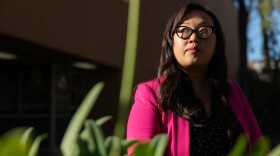San Diego Gas and Electric claims its mission is to provide more energy from solar, wind... and biomass. But, the company is lagging far behind California's two other major utilities in meeting a key state deadline for generating power from sources that don't pollute. KPBS Reporter Amita Sharma has more.
In 2002, California initiated an aggressive plan to clean up the air and slow global warming. It ordered energy suppliers to get 20 percent of their power from renewable sources by 2010 or face fines.
With two years until the deadline, Southern California Edison generates 16 percent of its energy from solar, wind and geothermal sources. Pacific Gas &Electric 12 percent. SDG&E ONLY 6 percent.
Rose: Their effort to develop renewables in San Diego has been incomplete at best and intentionally compromised at worst.
Craig Rose is energy adviser to San Diego City Attorney Mike Aguirre.
Rose: When it comes to global warming, the scientists tell us time counts. If SDG&E doesn't make it by 2010 that's a setback.
Rose says SDG&E's strategy is to rely on construction of the proposed 1.5 billion dollar Sunrise PowerLink transmission line. SDG&E's Jennifer Briscoe says that line is needed to meet the region's future energy demand and to connect to solar and geothermal projects in the Imperial Valley.
Briscoe: We have said that without the Sunrise PowerLink it will be very difficult to meet the mandate.
But the company has given conflicting statements on whether meeting the mandate depends on construction of the powerlink. Last year, a company official testified to state regulators that SDG&E's existing transmission network would be adequate to meet the state's 20 percent goal. This year, SDG&E told the Securities and Exchange Commission, without Sunrise, it is unlikely to hit the deadline.
The Public Utilities Commission is the agency that will approve or deny Sunrise. It will also enforce the 2010 renewable mandate. But the PUC's own energy adviser Andy Schwartz is unclear on how that will work.
Schwartz: There is a general view that transmission to access the Imperial Valley is critically important to the state meeting its renewable mandates. Whether I can say definitively absolutely has to have Sunrise in order to meet their mandate, you know it would be premature to say.
But even if SDG&E gets the green light from regulators to build Sunrise….San Diego's consumer watchdog Michael Shames of UCAN says there are no guarantees.
Shames: There is nothing in that approval that would require SDG&E to bring renewable power over that power line.
SDG&E's plan is to transmit power through Sunrise from a solar technology called Dish Sterling. Briscoe says the technology has worked in a laboratory. But it's never been tested commercially. And there are only seven solar dishes in operation right now. To meet future energy needs, SDG&E would require 12 thousand. Local engineer and environmentalist Bill Powers says at a time when solar energy is experiencing a resurgence, SDG&E has picked the one technology that's not ready for primetime.
Powers: You could have picked anything. Wind, solar trough, photovoltaic, geothermal. Anything. They're all commercial. They're all ready to go. And yet the technology that was chosen to be the centerpiece of this transmission proposal is one that can't be ready by the date which the contract requires it to be."
SDG&E recently unveiled an initiative that includes building small solar projects on top of covered parking lots. Briscoe of SDG&E says ultimately, the company hopes to generate enough electricity for 50,000 homes.
But Craig Rose of the city attorney's office says the effort is too small. He says, the company should borrow an idea from Southern California Edison and cover commercial rooftops across the city with solar panels. In other words, Rose says SDG&E needs a plan B.
Amita Sharma, KPBS News.





